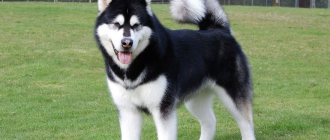6.09.2012 | Views: 7 346
Command "Come to me" . The puppy learns to approach its owner on command while walking. Choose a moment when the puppy is not busy with his “business,” call him by name so that he looks in your direction, and then say the command: “Come to me!” and do what will attract the puppy to you: bend over and pat yourself on the knees, sit down, smack, whistle - anything, but so that he runs to you. While the puppy is on the way, take a piece of treat out of your pocket and show it to the puppy, this will increase his speed.
As soon as the puppy runs up, give him a treat, pet him, play with him , holding him near you for a few seconds, and then release him, saying: “Walk!” .
Do this several times during your walk, not just when you are about to go home, and repeat every day until your dog runs to you when called.
If problems arise: the growing puppy becomes overly interested in dogs, cats, smells, or is simply stubborn, use a long leash. The command “come to me” is accompanied by a jerk of the leash , and if this is not enough, pull the dog towards you, fingering the leash. When the puppy is a meter away from you, repeat the command and jerk. Praise the dog when it comes up with affection and treats . A long leash can be replaced with a regular 1.5 - 2 meter leash, letting the dog go with it. If the dog does not approach, but does not run away, you can step on the end of the leash; the rest is a matter of technique.
Never punish a dog if it runs away, becomes stubborn, does something, but then still comes on command. She will associate the punishment not with the offense, but with the execution of the command and will stop following it. If you need to punish a dog, catch it by the leash without calling it, or have someone else catch it and bring it to you.
For a wayward puppy who does not want to leave the company of other dogs, your calls are completely meaningless: “I’m leaving, I’m going home,” etc.
It is better to ask the owners of other dogs to catch your puppy and hold it by the collar. Come over, fasten the leash and proceed as described earlier. Be sure to praise the dog when it comes up, even if you don’t want to do it at all. If, when you call him, the puppy is staring somewhere or sniffing and pretends that he does not hear, throw a rolled up leash, chain, or stone at him, aiming for the middle of the body. When he finally pays attention to you, sit down, clap, etc., affectionately repeating: “Come to me!” If it does, praise it.
Video tutorial on the “Come to me” command
Why do you need Labrador training?
Dogs are smart. However, without developing its natural potential, an adult dog can cause a lot of trouble. Animals that do not know what training is can ignore the owner’s requests, show spontaneous aggression, bark at passers-by, cars, and chase cats.
This is interesting: Rating of dogs by intelligence
This is interesting: Rating of dogs by intelligence
Some breeds were created for specific functions. Dogs have developed instincts of hunters, shepherds, and fighters. Therefore, it is important that the dog knows how to control emotions and strength. Otherwise, the dog will become dangerous to the family and society.
Training the dog will solve the problem. Mastering at least the basic level will turn the animal into a well-mannered, manageable pet that does not cause discomfort to others.
Labradors are intelligent and easy to train. Problems rarely arise during training with dogs.
This is interesting: Does a nickname affect the fate of a dog?
Golden Retriever as a guard
With all their advantages (or rather even because of them), golden retrievers are not at all suitable for protection or guarding : they are never aggressive with people (except for cases where there are serious behavioral disorders).
for any Golden Retriever training course . This is not necessary for service, but to achieve mutual understanding and expand your common capabilities.
- training
- Retriever
If you find an error, please select a piece of text and press Ctrl + Enter.
General rules for training a Labrador
There are different methods of conveying new information to the dog. Working plans are built based on the characteristics of the breed and the individual needs of the dog. However, there are conditions that must be complied with.
Forbidden:
- move on to new commands without mastering the old ones;
- Conduct the first 3 workouts in a noisy place where there are a lot of irritating factors;
- overwork the dog;
- get nervous, yell at the dog;
- Do not reward your pet with treats for doing the right thing.
Neglecting the recommendations of specialists will negatively affect the work process and delay the result.
Training should evoke positive emotions in your Labrador puppy.
Training at 4 - 5 months
By this time, the golden retriever puppy has already become accustomed to your home and usual walking areas, and no longer needs your support and care so much. He begins to flirt with other dogs, pretend that he does not hear you when you call him, and show a certain persistence and disobedience when performing various commands.
This means it's time to move on to full training . In classes at this age you can already be persistent and demanding. At the same time, the most important thing is not to overdo it, remember that classes should bring joy to both you and your dog, and only then you can achieve the desired result.
Required commands in 4 months
What commands are practiced by a golden retriever puppy at 4 months:
- Calm movement next
to the owner with and without a leash, with landing when stopping, with a change in pace and direction of movement - Return to you
on command - Exposure
in a free or certain position (sitting, lying, standing) - Indifferent attitude towards treats scattered on the ground
- Inhibitory command
to stop unwanted actions - Execution of a set of commands “sit”, “lie down”, “stand”
at a distance and near the leg, when giving commands by voice and gestures - Stop barking
on command.
General training course
Basic dog training methods are based on the principles presented by Academician I. Pavlov. The owner’s goal is to develop reflexes in the animal that are responsible for determining further behavior.
When training a Labrador, the development of the pet's senses is of great importance. The dog’s ability to see the world in black and white does not limit the dog’s potential in recognizing human movements and facial expressions. But the Labrador has problems identifying shades.
This is interesting: How to accustom a Labrador to a home environment?
In the absence of health deviations, the animals’ hearing is ideally developed. Dogs hear quiet sounds and rustling sounds.
A dog's sense of smell is 10 thousand times stronger than a human's.
The Labrador is able to distinguish those odors that people cannot even remotely smell.
During classes, you need to pay attention to the psychological characteristics of the ward, analyze the actions of the dog.
Types of possible dog reactions:
- physiological;
- protective;
- food;
- approximate.
The tendency to a certain type of behavior depends on genetics and the upbringing of the individual. In order to correctly take into account the characteristics of your pet and choose effective training methods, it is necessary to conduct a test.
Task conditions:
- You will need 2 assistants.
- In the morning the dog is placed in an unfamiliar environment. Shelters must be provided there. A landfill or a country yard would be suitable.
- To prevent the pet from running away, it is tied.
- The owner leaves the area.
- The partner, passing close to the Labrador, begins to make noise, and after 5 minutes leaves.
- The second person pretends to attack the animal, waving his arms, screaming.
- A bowl of food is placed in front of the dog. Repeatedly portray aggression.
After each stage, it is necessary to observe the dog’s reaction. This will reveal the type of prevailing behavior. If, despite the conditions, the dog tries to quickly empty the bowl, it means that the dog has a predominant food reaction.
Labradors tend to exhibit protective reflexes, adapt to the situation with lightning speed, and defend themselves by barking.
Level of emotionality of the animal:
| Temperament types | Characteristics of the dog |
| Choleric | Restless, efficient |
| Sanguine | Energetic, balanced, easy to learn |
| Phlegmatic person | Slow, motionless. Reflexes are difficult to develop, but are remembered for a long time |
| Melancholic | Easily hurt, relaxed. Difficult to educate |
Labrador retrievers can have mixed temperaments. Therefore, observations should not be stopped during the training period. Neglecting the rule, you can make mistakes that provoke rapid fatigue of the dog, fear of the owner, or aggression, neuroses. Failure to adhere to the training schedule, ignoring the dog’s characteristics, and consistent use of opposing commands lead to a similar result.
Possible difficulties
It is recommended to start working with a dog from 2 months. In adulthood, during training, many owners encounter difficulties arising from the impulsiveness of the breed. Dogs are often distracted, try to escape from classes, and prefer games.
Labradors are able to outwit the owner by luring out treats. At the same time, dogs make ideal hunters, guides, and trackers. Dogs are also capable of guarding skills, but with difficulty.
Labradors are equally trainable at any age. Able to remember a command 2-5 times.
Sometimes puppies already perform complex tasks at 3 months of age.
What to follow when raising a child
A Golden Retriever is usually given to a new owner at the age of 7-8 weeks - not enough for full training . However, it is at this time that the foundations are laid that will affect the dog's relationship with you and with the world in the future.
There are only two basic principles for raising a puppy of any breed. Need to:
- form and develop useful, functional conditioned reflexes, encourage desired behavior;
- create conditions in which harmful reflexes are inhibited and unacceptable behavior does not occur.
This is harder than it seems: it happens that, without realizing the consequences, we encourage unwanted behavior. For example, we pay attention to the dog when it actively demands it, being a hooligan. “Okay,” we say, “if that’s what you ask, so be it, let’s play.” "ABOUT! - the dog thinks, - scattering the shoes works! We need to take note of this method.”
Remember that Goldens are intelligent dogs and only need a few rewards to reinforce a skill, whether you like it or not.
Nuances of education
Well-planned training is 50 percent of success. The trainer needs to remember that if there is an excess of feelings, it is difficult to achieve the dog’s obedience. And the owner’s persistence will cause emotional suppression of the pet.
Before the lesson, the Labrador should have played enough and be a little tired. A leisurely walk on a leash will distract your dog from entertainment. After 10-15 minutes you can try to call your pet. If the Labrador immediately responds to the call, it is ready for training, but ignores its nickname - the nervous system has not yet returned to its normal state.
For boys
When working with male dogs, you need to learn how to keep the dog's attention on you. The owner should give priority to dogs running past.
The hardest thing for Labradors - boys - is to resist the temptation to be distracted by a playful lady during the period of heat.
Girl
Bitches have their own difficulties. The trainer has to adapt to frequent mood swings or learn to stabilize the emotional swings of the four-legged animals. Instability is associated with hormonal levels.
Expert opinion
Anna Abramenko
An avid dog lover. Experience in veterinary medicine since 2009.
Ask a Question
When your pet becomes distracted, it is better to postpone training. The best option is to start raising a girl at 2 months.
Command training
Having trained a Labrador puppy to use the toilet, behave properly on the street, and eat, you need to delve deeper into mastering basic tasks.
- “Place” is one of the basic commands that every dog should know. Having voiced it, you need to take the pet to its bed. Sudden movements are not allowed; it is allowed to hold the Labrador by the collar. After placing the dog on the bedding, you need to give him a treat. After completing the reception, it is repeated until the pet remains in its place.
- "Sit". The owner comes close to the dog, sits the Labrador down, applying pressure on the back with his palm. After this, you need to say the command loudly. The puppy has completed the task and receives a treat.
- "Lie". Lessons are conducted in the same way. Trainers place the dog on the floor, resting their hand on the croup.
- "Stand". When the dog is sitting, you need to pull it by the collar with one hand, show an upward gesture with the other, and indicate the command verbally.
- “Bring it.” Chain of actions: throw the ball, ask your four-legged friend to catch it and return it to the owner.
- "To me". This command is necessary on walks. If the dog does not master it, then the Labrador cannot be let off the leash. Practice the reflex in natural home conditions. When calling the dog, they give a treat.
- "Near". During the walk, you need to keep your pet on a short leash, pronounce the command “nearby”, and offer treats.
- "Ugh". A piece of his favorite food is placed in front of the animal. As soon as your pet reaches for a treat, you need to say “ugh” and hit it on the face with a rolled-up newspaper. It doesn't hurt, but it will cause discomfort for the dog.
- "Voice". It is necessary to ensure that, on demand, the animal begins to bark. Labradors quickly understand the essence of the trainer's wishes. To teach the “voice” command, it will take from 2 to 10 training sessions.
- "Give". The drill is taught through fun. While playing with a toy, you need to ask the dog to give it back.
- “Fetch” is one of the favorite tasks of dogs. They begin to perform it after the dog learns the commands: “fu”, “come to me”. This will make it easier to manage the animal on the street. It is necessary to show the pet a stick (ball) and throw it a short distance, let the Labrador off the leash, and shout “fetch.” The dog must bring the item and receive a treat.
Expert opinion
Anna Abramenko
An avid dog lover. Experience in veterinary medicine since 2009.
Ask a Question
Commands must be repeated daily, bringing the execution to automaticity. It is important to develop a strict tone and a confident look.
At what age do you start training?
Puppy training must begin from the very first days
the presence of a dog in your home. Because already from infancy, the puppy must learn the rules of behavior in your house, what is allowed and what is forbidden, how to behave with all family members, even the smallest and oldest, what he can play with and what he can’t, where to go. toilet and much more.
And we are talking, first of all, about the proper upbringing of a Labrador puppy, and you can start training and learning commands when the puppy is completely comfortable in your home. As a rule, one week is enough. By this time, the puppy is already filled with curiosity and is diligently exploring the world around him. If, after this time, the puppy remains fearful and does not make contact well, then it is better to seek help from a dog handler-animal psychologist, because This behavior is not typical for puppies of this breed.
When can you start training with a dog handler?
The beginning of the puppy's training coincides with the time of the first exit to the street. When the first two vaccinations have already been done, the quarantine (lasts 7-14 days, depending on the vaccination) after them is over. It is not at all necessary to train your puppy only outside; the first sessions are best done at home, where there are fewer distractions.
Often new puppy owners worry that training from the first days will be excessively stressful for the dog. This is only possible if outdated, rigid methods are used, and with the right approach, training from the first days will, on the contrary, be very useful, since it allows you to immediately establish contact
with the puppy and build a trusting relationship.
You can start raising a puppy from the first days of its appearance in your home, and training and classes with a dog handler can begin simultaneously with the start of walks, when quarantine ends after the second vaccination.
Why you don't need to wait up to 6 months
You often hear that Labradors, like other dogs, cannot be trained before 6 months, because training is stressful. This opinion remains from the times of outdated methods based on cruel coercion and intimidation of the dog. Unfortunately, there are still plenty of dog handlers using similar techniques today. But fortunately, science does not stand still and modern techniques make it possible to train a puppy from the first days in a new home. Therefore, you should not wait until your Labrador puppy has established unwanted behavior; you can start training much earlier.
Punishment and reward
The behavior of even the most well-mannered dogs sometimes causes criticism. In order for the puppy to understand his mistakes, you need to correctly point out them. It is important to focus on your pet’s good deeds. This will reinforce positive behavioral skills in your Labrador.
It is necessary to think over a scheme of praise and punishment. Both methods must be present in the process of developing the Labrador's character.
Expert opinion
Anna Abramenko
An avid dog lover. Experience in veterinary medicine since 2009.
Ask a Question
Puppies are often mischievous during childhood. This requires a prompt response from the owner. You need to let the animal know that it did something bad. It is permissible to point out the damaged item, say strictly “ugh”, and not play with your pets for the next hour.
The baby relieved himself in the house because the owner did not take him for a walk - you cannot scold a pet. The man himself provoked such an act.
When a dog willingly follows the owner’s commands, it deserves a reward and should receive it immediately - a treat, praise.
Yelling at the animal or hitting it is strictly prohibited. Otherwise, he will grow up to be a frightened dog with mental problems.
How to train a puppy to behave well at home
The rules of behavior in the house should be clear from the first days for a dog of the Golden Retriever breed. Raising a puppy , as a rule, begins with toilet training. This issue must begin to be resolved by demonstrating the proposed toilet. After each feeding, the puppy must be carried there, and if he uses the tray for its intended purpose, he must receive a reward. It is advisable to try to pronounce the command “toilet” so that the dog has the necessary associations. There is no need to scold the baby if he did not have time to reach the tray and made a puddle in the room. A strict feeding and walking regimen will help reduce the number of incidents. You need to walk your puppy often, every few hours, except at night. An observant owner will see signs of a necessary walk - if the animal whines and is worried, then most likely it wants to go to the toilet.
Basic mistakes
During training, you should not overdo it with the same commands. Labrador Retrievers can become bored with the monotony of tasks. Numerous fetchings will provoke a refusal to bring toys to the owner.
If the dog gets off the leash and runs, there is no point in catching up with him. You need to shout “to me” in a demanding tone. Chasing can be perceived as a game by your Labrador.
Dogs should not be allowed to stay in the water for long periods of time. Animals love to swim; when they feel out of control, they will ignore the trainer’s calls and go ashore.
Golden Retriever as a Family Member
The Golden Retriever will love you all - he will get along with a cat , another dog, children and your relatives to the seventh generation. But only with proper education and respect for the personal space of the retriever himself:
- children should be informed that they must not bother the dog, drive it away from its place, offend it, shout or fight;
- acquaintance with other animals should be natural, non-violent: you cannot deliberately bring animals together in a cramped room, they should have space for maneuver or privacy if they do not want to get to know each other.
Tips from dog handlers
Recommendations that dog handlers do not recommend neglecting:
- Study the characteristics of the breed before purchasing a puppy. This will allow you to competently educate the creature and build an effective work scheme.
- Choose a suitable place to study. The room, the courtyard, should be quiet, spacious, and comfortable.
- Walk your dog regularly.
- Do not allow assault, even if the dog is very guilty.
- Monitor the schedule of necessary vaccinations. Visit veterinary clinics.
- Express dissatisfaction or praise fairly, after analyzing his actions.
- Give commands in a stern, non-rude tone. The dog should want to obey, not be afraid.
- Provide the animal with sufficient, balanced nutrition.
- Find time for tenderness every day. Don't neglect the opportunity to pet your pet. This will make the relationship between dog and owner warm and trusting.
- Don't give up on classes. Acquired skills require constant reinforcement.
Following the advice of dog handlers, even for novice dog breeders it will not be difficult to get a disciplined, wise dog.
Having mastered the basic skills of the training course, you need to move on to complicating the program. Labradors have great potential. With the right approach of the owner, it can be fully revealed. Then the dog will become not just a friend, but the main protector and assistant.
How to crate train
The crate is indispensable when traveling, or if it is necessary to isolate the dog and children from each other. The box should be of a comfortable size and located in a warm room. Iron rods should be covered with a soft cloth, and bedding and toys should be placed inside. The dog must itself go into the cage to the thing that interests it. For being there, reward the retriever with a treat. The main goal is for the cell to begin to associate with the treat. You can start locking the door only when the dog doesn’t mind being inside and doesn’t want to get out. Leaving a locked retriever alone should be done gradually, starting from 5 minutes.
Video tutorial on training
Proper education of a Labrador, building relationships with your pet, an effective approach to learning commands. All this is presented in a video tutorial based on the experience of dog handlers.











